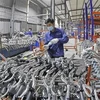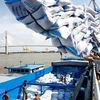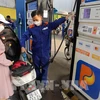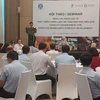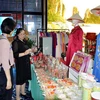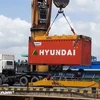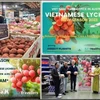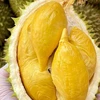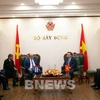The recent mechanisation of sedge-mat production brought wealth to some Mekong Delta villagers. But those who can't afford the pricey machines are being left out of the economic windfall, opting instead for industrial jobs or less lucrative subcontracting work in the work.
Sedge materials and mats are scattered along the road and the sound of weaving machines echoed from every house in the Long Dinh craft village. Even though it is Sunday, it seems nearly every resident in Tien Giang province's Long Dinh village was weaving, drying, dying or transporting sedge mats or raw materials. Evidence of this new prosperity can clearly be seen in the newly built houses lining Road 867 in Chau Thanh district.
"My family was the first to use machines," said Pham Thi Ngoc Yen, whose family began weaving mats on handmade looms in 1954 and has been weaving mats on semi-automatic looms for 10 years. They now have 15 machines.
Yen's and other weaving families had migrated from the northern province of Ninh Binh. "Then other families began to buy them and the living conditions of workers improved."
Today, with mechanisation, production is substantial enough to export mats to China’s Taiwan, Japan, the Republic of Korea and Europe.
Local residents say they have become well-off from exporting sedge mats. More than 1,000 households in the village operate sedge-mat weaving workshops that employ thousands of local residents. Nguyen Minh Dung, who has a workshop a few steps from Yen's house, is also well-known in Long Dinh village for his business acumen and wealth that came after he mechanised production.
While Dung and Hoc were pioneers in using the new technique, Ho Thi Thanh Dao, owner of a mat workshop in neighbouring province Long An, was an early adopter. Dao works in Long Dinh craft village, which shares the same name as its counterpart in Tien Giang.
In the past, Dao recalled, it took her an entire day to finish two or three mats. "I was scared of this job when I became a member of the family because it was very hard. Everything had to be done manually," she said.
Then in 2001, the family bought mechanical looms and began producing more than 50 pieces a day. "Because of the demand from clients, including military agencies and supermarket chains, I was forced to upgrade our production system," Dao said.
A few years later, after buying power looms that have higher yields, her workshop now employs 30 people. Each person can make 100 mats day, earning about 5 to 6 million VND (300 USD) a month. "Three decades ago, the family's income was barely enough to survive. With traditional production methods, we could only make enough for local markets," she said.
While Dao and her family have prospered, other weaving families in her commune have had to quit or face bankruptcy. As the machines became popular, more households began buying them and supply became abundant, creating a more competitive market.
Some households could not afford the capital to fully mechanise their work, and others were unable to find a stable market for their goods, according to Dao. Although some families have succeeded, many others in the 100-year-old sedge-mat village in Long An have shifted to other jobs.
Dao said the abundance of work in Long An's industrial parks was a factor in that shift, while in Tien Giang, the craft village there has thrived because of plentiful sources of raw materials, lack of factory jobs and good management.
Dao said many households had been making a small profit and could not pay interest on their bank loans. In addition, another province in the Mekong Delta, Dong Thap, has been conquering the market with much cheaper prices for its sedge mats made with machines, she said. As industrial parks and new residences have taken up land for cultivating sedge, weavers in Long An lack sufficient raw materials to make mats.
Nguyen Thi Khanh Trang, 59, owner of a mat workshop in Long An's Long Dinh Commune, said that she had experienced difficulty finding workers. "They love to work for the companies in industrial parks where they can get better salaries," she said. Only five of seven machines are operating at her workshop because of the staff shortage.
"Business was very good in the past before the industrial parks were built in the region," Trang said, adding she was envious of Dong Thap which has abundant material resources and few factories. "I want to sell all of my machines and quit, but I can't find buyers, and my husband won't allow me to do this because weaving was our parents' career," she said.
Another local weaver, Pham Do, 60, who has made mats for 38 years, said the lack of sedge was a disadvantage in Long An. In order to have enough raw materials, Do must travel to a neighbouring district to rent 0.5 hectare of land to cultivate sedge, as industrialisation in his native Can Duoc District has taken land away from cultivation. Do now makes three mats a day. "The income is barely enough for me to feed my family," he said.
Because he has no money to invest in power looms, which cost at least 30 million VND, Do has chosen to collaborate with others by sub-contracting work. Besides making mats, he sells the sedge that he cultivates to mat workshops.
Nguyen Thi Ngan, 35, also of Long An, who has made mats since she was 11, has chosen a similar strategy. Besides working on a machine at a workshop, she takes home decorating and finishing work, earning a total of 2 million VND.
In Tien Giang, where work is even more plentiful, many weavers unable to invest in power looms have survived by subcontracting work.
Nguyen Tuyet Lan said she takes home completed mats to finish, earning 50,000 VND a day. Five years ago, when the village had no mechanical looms, she also made sedge mats by hand. "Without money to buy a machine, I cannot compete with them if I had continued to produce the traditional way, so collaboration with other households is the better way," Lan said.-VNA
Sedge materials and mats are scattered along the road and the sound of weaving machines echoed from every house in the Long Dinh craft village. Even though it is Sunday, it seems nearly every resident in Tien Giang province's Long Dinh village was weaving, drying, dying or transporting sedge mats or raw materials. Evidence of this new prosperity can clearly be seen in the newly built houses lining Road 867 in Chau Thanh district.
"My family was the first to use machines," said Pham Thi Ngoc Yen, whose family began weaving mats on handmade looms in 1954 and has been weaving mats on semi-automatic looms for 10 years. They now have 15 machines.
Yen's and other weaving families had migrated from the northern province of Ninh Binh. "Then other families began to buy them and the living conditions of workers improved."
Today, with mechanisation, production is substantial enough to export mats to China’s Taiwan, Japan, the Republic of Korea and Europe.
Local residents say they have become well-off from exporting sedge mats. More than 1,000 households in the village operate sedge-mat weaving workshops that employ thousands of local residents. Nguyen Minh Dung, who has a workshop a few steps from Yen's house, is also well-known in Long Dinh village for his business acumen and wealth that came after he mechanised production.
While Dung and Hoc were pioneers in using the new technique, Ho Thi Thanh Dao, owner of a mat workshop in neighbouring province Long An, was an early adopter. Dao works in Long Dinh craft village, which shares the same name as its counterpart in Tien Giang.
In the past, Dao recalled, it took her an entire day to finish two or three mats. "I was scared of this job when I became a member of the family because it was very hard. Everything had to be done manually," she said.
Then in 2001, the family bought mechanical looms and began producing more than 50 pieces a day. "Because of the demand from clients, including military agencies and supermarket chains, I was forced to upgrade our production system," Dao said.
A few years later, after buying power looms that have higher yields, her workshop now employs 30 people. Each person can make 100 mats day, earning about 5 to 6 million VND (300 USD) a month. "Three decades ago, the family's income was barely enough to survive. With traditional production methods, we could only make enough for local markets," she said.
While Dao and her family have prospered, other weaving families in her commune have had to quit or face bankruptcy. As the machines became popular, more households began buying them and supply became abundant, creating a more competitive market.
Some households could not afford the capital to fully mechanise their work, and others were unable to find a stable market for their goods, according to Dao. Although some families have succeeded, many others in the 100-year-old sedge-mat village in Long An have shifted to other jobs.
Dao said the abundance of work in Long An's industrial parks was a factor in that shift, while in Tien Giang, the craft village there has thrived because of plentiful sources of raw materials, lack of factory jobs and good management.
Dao said many households had been making a small profit and could not pay interest on their bank loans. In addition, another province in the Mekong Delta, Dong Thap, has been conquering the market with much cheaper prices for its sedge mats made with machines, she said. As industrial parks and new residences have taken up land for cultivating sedge, weavers in Long An lack sufficient raw materials to make mats.
Nguyen Thi Khanh Trang, 59, owner of a mat workshop in Long An's Long Dinh Commune, said that she had experienced difficulty finding workers. "They love to work for the companies in industrial parks where they can get better salaries," she said. Only five of seven machines are operating at her workshop because of the staff shortage.
"Business was very good in the past before the industrial parks were built in the region," Trang said, adding she was envious of Dong Thap which has abundant material resources and few factories. "I want to sell all of my machines and quit, but I can't find buyers, and my husband won't allow me to do this because weaving was our parents' career," she said.
Another local weaver, Pham Do, 60, who has made mats for 38 years, said the lack of sedge was a disadvantage in Long An. In order to have enough raw materials, Do must travel to a neighbouring district to rent 0.5 hectare of land to cultivate sedge, as industrialisation in his native Can Duoc District has taken land away from cultivation. Do now makes three mats a day. "The income is barely enough for me to feed my family," he said.
Because he has no money to invest in power looms, which cost at least 30 million VND, Do has chosen to collaborate with others by sub-contracting work. Besides making mats, he sells the sedge that he cultivates to mat workshops.
Nguyen Thi Ngan, 35, also of Long An, who has made mats since she was 11, has chosen a similar strategy. Besides working on a machine at a workshop, she takes home decorating and finishing work, earning a total of 2 million VND.
In Tien Giang, where work is even more plentiful, many weavers unable to invest in power looms have survived by subcontracting work.
Nguyen Tuyet Lan said she takes home completed mats to finish, earning 50,000 VND a day. Five years ago, when the village had no mechanical looms, she also made sedge mats by hand. "Without money to buy a machine, I cannot compete with them if I had continued to produce the traditional way, so collaboration with other households is the better way," Lan said.-VNA

